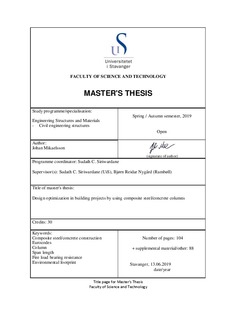| dc.contributor.advisor | Siriwardane, Sudath C. | |
| dc.contributor.advisor | Nygård, Bjørn Reidar | |
| dc.contributor.author | Mikaelsson, Johan | |
| dc.coverage.spatial | Norway | nb_NO |
| dc.date.accessioned | 2019-10-09T08:32:48Z | |
| dc.date.available | 2019-10-09T08:32:48Z | |
| dc.date.issued | 2019-06-13 | |
| dc.identifier.uri | http://hdl.handle.net/11250/2621080 | |
| dc.description | Master's thesis in Structural engineering | nb_NO |
| dc.description.abstract | While being relatively common in other parts of Europe, the construction of steel-concrete composite buildings in Norway is rare. As an introduction the constituent materials, examples of different composite building elements and examples of the usage of composite elements in building constructions of different parts of the world are given.
The main part of this thesis investigates the structural and environmental benefits of using composite instead of steel columns when they are designed according to the Eurocode rules. To introduce the reader to composite column analysis, ultimate limit state and fire calculations of an HE-300B steel column are given both for a reference pure steel column and for one fully encased in concrete. Significant improvements in resistance are shown for the fully encased column for all types of loads except shear force.
Parametric comparisons between composite and steel columns are given for:
- The maximum span length which can be achieved in similarly dimensioned pinned and rigid rectangular frames. By only considering the resistance of the columns and by encasing a steel column fully or partially in concrete, the span length is increased between 30% and 100%.
- The minimum column depth required for a number of different load cases and fire load-bearing resistances. While the results varied, the composite columns in general allowed for a depth reduction towards the steel column.
- The load-bearing resistance achieved per steel cross-sectional area. This study shows that concrete filled tubular columns can achieve the same load bearing resistance as a steel column by using less than half the amount of steel. Partially encased steel composite columns require approximately 75% of the steel amount on average. These results are however dependent on factors such as end moments and the column buckling length. Adding reinforcement to partially encased or concrete filled tubular composite columns is not an efficient way to increase the strength or stiffness.
- The environmental footprint by determining the CO2 mass equivalents and the energy use associated with production of the column building materials. The composite columns are better than those made of steel on both accounts, except for concrete filled tubular columns where larger amounts of CO2 are emitted in production.
Two software tools were specifically written in MATLAB for the parametric studies. One for analysing the maximum span length of steel and composite columns in a rigid frame by using an element method, another for doing member verifications of reinforced concrete filled tubular columns according to Eurocode 4.
The final part of this thesis is a case study of a single storey in-door sports hall with a no-sway steel frame. The HE-300B steel columns are replaced by partially encased composite columns to investigate whether the columns can be made thinner that way. For normal temperature conditions a partially encased HE-240A is sufficient. When fire load-bearing resistances are considered, the columns cannot be calculated according to the simplified calculation rules of Eurocode 4 due to length restrictions. However, R15 resistance can be achieved with by calculating an encased HE-240B for fire loads in accordance to Eurocode 3. Based on indicative calculations using the simplified calculation rules of Eurocode 4; it is also likely that R30 resistance is achievable with a HE-240B section, while R60 resistance is unlikely. | nb_NO |
| dc.language.iso | eng | nb_NO |
| dc.publisher | University of Stavanger, Norway | nb_NO |
| dc.relation.ispartofseries | Masteroppgave/UIS-TN-IMBM/2019; | |
| dc.rights | Navngivelse 4.0 Internasjonal | * |
| dc.rights.uri | http://creativecommons.org/licenses/by/4.0/deed.no | * |
| dc.subject | Eurocodes | nb_NO |
| dc.subject | engineering structures | nb_NO |
| dc.subject | materialteknologi | nb_NO |
| dc.subject | konstruksjonsteknikk | nb_NO |
| dc.subject | byggkonstruksjoner | nb_NO |
| dc.subject | materials science | nb_NO |
| dc.subject | composite steel/concrete construction | nb_NO |
| dc.subject | column | nb_NO |
| dc.subject | span length | nb_NO |
| dc.subject | fire load bearing resistance | nb_NO |
| dc.subject | environmental footprint | nb_NO |
| dc.title | Design optimization in building projects by using composite steel/concrete columns | nb_NO |
| dc.type | Master thesis | nb_NO |
| dc.subject.nsi | VDP::Technology: 500::Building technology: 530::Construction technology: 533 | nb_NO |

